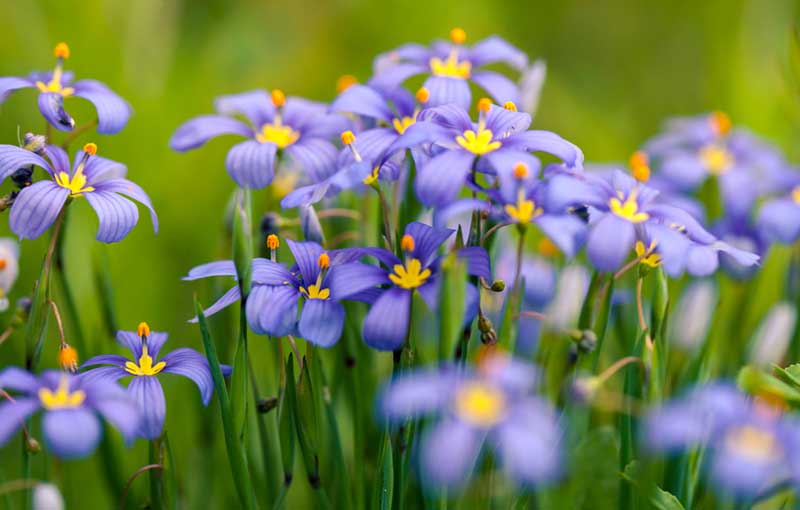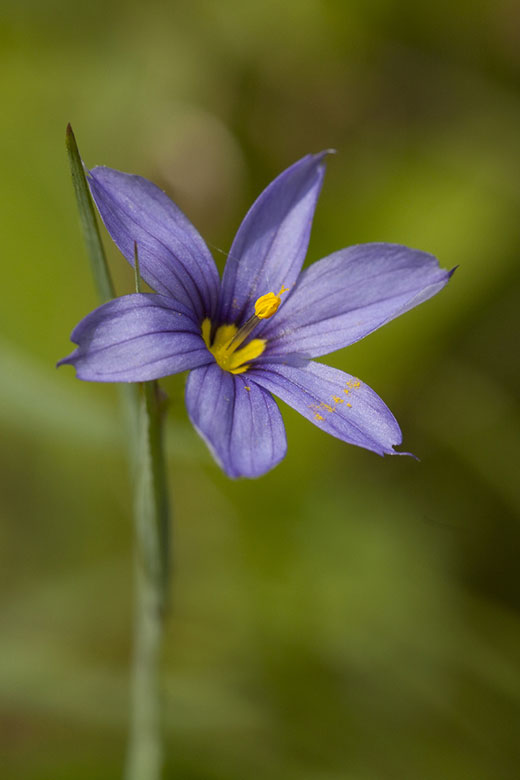
Blue-eyed grass (Sisyrinchium sp) grows freely throughout much of North America. It includes a wide range of species ranging from 50 to 150, depending on the plant classification system used, explains the University of Wisconsin Horticulture Extension. This delightful perennial can be found along stream banks, in moist meadows and along woodland edges. Most species are hardy in USDA plant hardiness zones 5 through 8, but some are cold hardy to zone 2 while others will thrive in zones 9. Despite their name and appearance, blue-eyed grasses aren’t grasses at all. This plant belongs to the Iris family.
Blue-eyed grass earns its name from its tiny strap-like leaves that closely resemble blades of grass. Flowers emerge atop a thin stalk that hold them slightly above the top of the foliage in late spring or early summer, depending on the species and location. Cheery blue or purple flowers feature six petals with a bright yellow center. Foliage grows in a fan-like clump characteristic of the iris family.
Light and Temperature Requirements
Blue-eyed grass thrives in full or partial sun, but blooming will be inhibited if it gets too much shade. As a rule, full sun refers to areas that receive 6 to 8 hours of direct sunlight a day, while partial sun refers to areas that receive 4 to 6 hours of sunlight a day. Aim for at least 5 to 6 hours of direct sunlight for your blue-eyed grass if you do not have areas in your garden that receive all-day sun. Keep in mind that the hours of sunlight do not need to be consecutive. A few hours in the morning, noonday shade and another few hours of direct sunlight in the afternoon will work well, too.
Watering
Blue-eyed grass prefers moist soil that does not dry out. That means it may need supplemental watering more frequently than your other perennials. Check the soil frequently and water your blue-eyed grass when the soil feels dry to the touch. It is best to water your blue-eyed grass early in the morning or in the evening. Watering during the heat of the day may damage foliage. Early-morning and evening watering allows the plants to absorb the moisture they need to withstand the heat of the day and prevents moisture loss to evaporation.
Soil & Fertilizing
Blue-eyed grass prefers poor to average soil that drains well. According to the Ladybird Johnson Wildflower Center, blue-eyed grass grown in soil high in organic matter encourages prolific foliage growth at the expense of fewer blooms. It further explains that applying heavy layers of mulch may seem like a good idea for keeping the soil moist, but it can cause crown rot in blue-eyed grass. Use mulch with caution leaving a 2- to 3-inch margin of soil un-mulched around the plants. Landscape fabric may be a better choice for controlling weeds and conserving moisture without the risks associated with heavy organic mulches.
Deadheading and Pruning
Blue-eyed grass doesn’t require pruning but may benefit from deadheading faded blooms. This tricks the plant into thinking it has not produced enough seeds to reproduce and sends energy into further flower production. The entire clump can be cut back after blooming to prevent seed production if you do not want them to self-seed in your garden. Cutting them back after blooming may force repeat blooming later in the season.

Propagation
Blue-eyed grass is propagated via root divisions. In fact, this short-lived perennial will depend on you to divide the clump every 2 to 3 years to promote vigorous growth and prevent it from dying out in your garden, says New Moon Nursery. To divide blue-eyed grass, use a garden fork or spade to dig around the clump. Slide the tines under the clump and lift it free from the soil. Remove any excess soil by shaking the clump or spray the root ball with the hose if necessary. Pull the roots apart leaving 3 to 4 shoots in each section. Replant the shoots in prepared soil with similar growing conditions as the original plant.
Growing from Seed
Blue-eyed grass can also be propagated via seed, but it requires patience. To grow blue-eyed grass from seeds gathered from your plants, gather the seeds and scatter them over the area you want them to grow in. These seeds need cold stratification to germinate in the spring. Planting them in the fall allows for natural stratification to occur. Otherwise, you will need to stratify them by putting them in the refrigerator for 6 weeks and then germinating them at temps between 50 and 60 degrees.
Seeds purchased via seed catalogs do not need to be cold stratified before planting, as the supplier has already done that for you. You can direct sow them in the garden in either spring or fall. Press the seeds into the soil, but do not cover them with soil. These seeds need light to germinate. Keep the area moist until seedlings appear. Blue-eyed grass grown from seed may not bloom for 2 years or more.
Blue-eyed grass makes a delightful addition to woodland or wildflower gardens and can be added to cottage gardens, too. Tuck this flower into rock gardens (as long as you can keep the soil moist) for a showy display in summer. Some varieties remain in bloom for two months or more.




